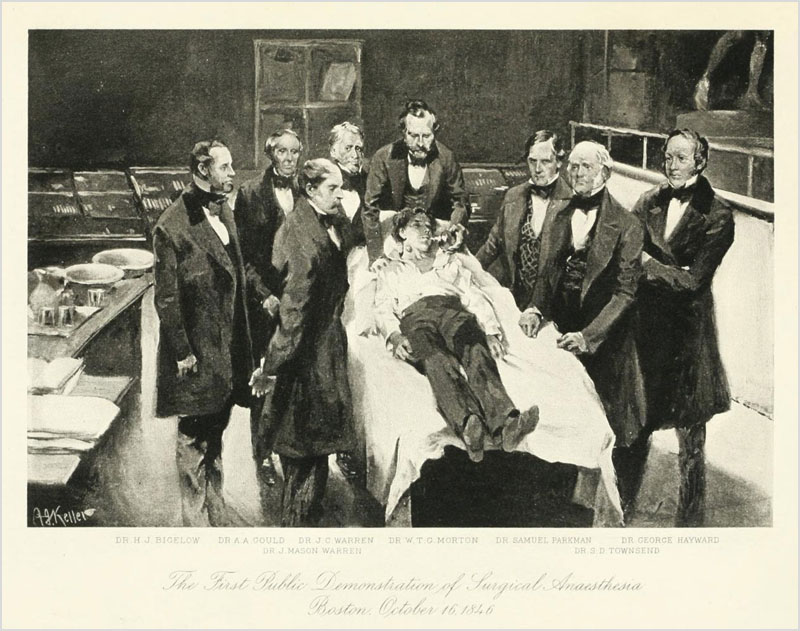

Keller's painting of the Abbott operation, 1896. Caption reads, "The first public demonstration of surgical anaesthesia. Boston, October 16, 1846." [From left to right: 1.) Dr. Henry J. Bigelow. 2.) Dr. Augustus A. Gould. 3.) Dr. J. Mason Warren. 4.) Dr. John C. Warren. 5.) Dr. William T. G. Morton. 6.) Dr. Samuel Parkman. 7.) Dr. T. D. Townsend. 8.) Dr. George Hayward.]
The published iconography of the idealized Abbott operation was next augmented by a painting by Arthur Ignatius Keller (1867-1924), which was reproduced by electrotype in the program for the semi-centennial jubilee of the introduction of anesthesia at Mass. General. (22 »») Save for a significant shift in perspective and the transposition of Hayward and Townsend, Keller's portraits are painterly interpretations of Hall's engraving. For his portrayal of Parkman, however, he copied the body of the "Fancy vest" figure in EDD No. 2. This important detail will be discussed in greater depth with my attribution of Dr. George Parkman, and it is an indication that Keller had access to EDD No. 2, published a year earlier and for the first time in the Transactions of the American Surgical Association. (23 »») The daguerreotype was always in the possession of the Warren family and accompanied the address of Dr. John Collins Warren, Jr. (1842-1927), upon his induction as President to the American Surgical Association for the year of the jubilee.
22.) Massachusetts General Hospital (1897), "The first public demonstration of surgical anaesthesia." Cambridge, Mass.: H. O. Houghton & Co; pl. facing page 17. The reproduction of Keller's painting is captioned, "The First Public Demonstration of Surgical Anaesthesia, Boston, Oct. 16. 1846."
23.) Warren Jr., JC (1896), "The influence of anesthesia on the surgery of the nineteenth century." In: Transactions of the American Surgical Association. Philadelphia: William J. Dornan ; vol. 15, plate facing page 1. This was a transcription of the Presidential address of J. Mason Warren's son, inaugurated in 1896. He was named after his grandfather John Collins Warren. The plate he describes is a reproduction of EDD No. 2, noting that his family was always in possession of the daguerreotype.
